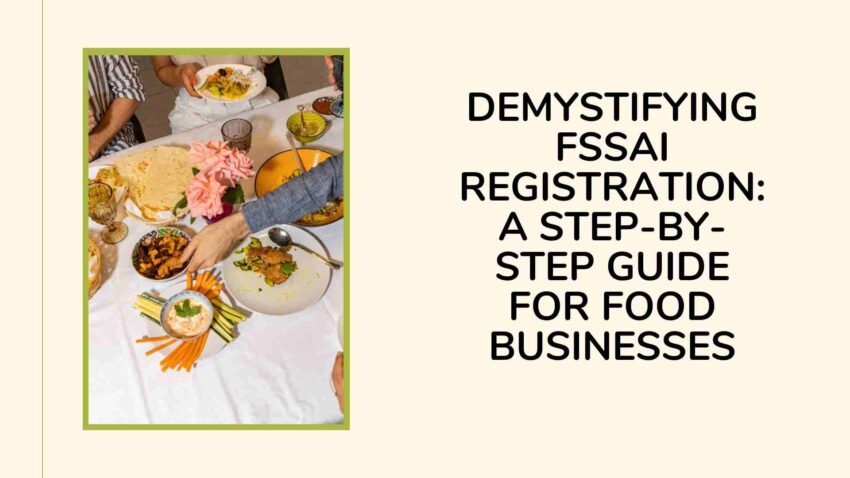The Food Safety and Standards Authority of India (FSSAI) registration is a mandatory compliance for businesses involved in the production, processing, packaging, distribution, and sale of food products in India. FSSAI is the apex regulatory body responsible for ensuring the safety and quality of food products to protect the health of consumers. Fssai registration is governed by the Food Safety and Standards Act, 2006, and it is applicable to various types of food businesses, including manufacturers, traders, restaurants, caterers, and those involved in the food distribution and processing chain. The registration process involves obtaining a unique 14-digit FSSAI license or registration number, which is a legal requirement for carrying out food-related activities.
Step 1: Determine the Applicability of FSSAI Registration:
The first step in the FSSAI registration process is to assess whether your business requires it. Different types of food businesses fall under different categories, each with its own set of requirements. Small-scale businesses may be eligible for basic registration, while larger enterprises may need a state or central license. Understanding the category that applies to your business sets the stage for the subsequent steps.
Step 2: Gather Necessary Documents:
Once the category is determined, gather the necessary documents for FSSAI registration. Common documents include proof of identity, address, and a list of food products manufactured or processed. Having these documents ready in advance streamlines the application process and ensures a smoother transition through subsequent steps.
Step 3: Choose the Correct FSSAI License Type:
Selecting the right type of FSSAI license is critical. This decision is based on factors such as the scale of operations, turnover, and the geographical extent of business activities. Small businesses may opt for a basic registration, while larger ones may need a state or central license. Choosing the correct license type ensures compliance with FSSAI regulations.
Step 4: Complete the Online Application:
FSSAI registration applications are submitted online through the FSSAI portal. Create an account on the portal and fill out the application form with accurate and up-to-date information. Double-check all details before submission to avoid unnecessary delays or complications.
Step 5: Pay the Applicable Fees:
FSSAI registration involves certain fees, which vary based on the type of license and the scale of operations. Pay the required fees through the online portal after completing the application. Keep the transaction details for future reference.
Step 6: Await the Application Processing:
After submission and payment, the FSSAI authorities will process the application. This may involve scrutiny of documents and, in some cases, an inspection of the premises. The processing time varies, but businesses can track the status of their application through the FSSAI portal.
Step 7: Receive the FSSAI Registration Certificate:
Upon successful verification, the FSSAI registration certificate is issued. This certificate serves as official documentation of compliance with food safety standards. Display the FSSAI logo on product packaging and promotional materials to communicate your commitment to quality and safety to consumers.
Step 8: Maintain Compliance and Stay Updated:
Obtaining the FSSAI registration certificate is not the end of the journey; it marks the beginning of a commitment to ongoing compliance. Ensure that your business adheres to the standards set by FSSAI by maintaining proper hygiene, regularly testing products, and keeping records up to date. Stay informed about any updates or changes in FSSAI regulations to proactively address evolving requirements.
Step 9: Implement Best Practices for Food Safety:
FSSAI registration is not just a regulatory obligation; it’s a pledge to prioritize food safety. Implementing best practices for food safety within your business operations is essential. This includes proper storage, handling, and processing of food products, as well as training staff on hygiene practices. A commitment to food safety not only meets regulatory requirements but also establishes your business as a responsible player in the industry.
Step 10: Display FSSAI Logo and Certification Number:
Once you have received your FSSAI registration certificate, proudly display the FSSAI logo on your product packaging and promotional materials. This not only communicates your compliance with food safety standards but also builds trust among consumers. Additionally, prominently showcase your unique FSSAI license or registration number, allowing consumers to verify the authenticity of your certification.
Step 11: Conduct Regular Audits and Assessments:
Regular internal audits and assessments are vital to ensuring continued compliance with FSSAI standards. Establish a systematic approach to periodically review your processes, documentation, and overall adherence to food safety protocols. This proactive approach not only minimizes the risk of non-compliance but also fosters a culture of continuous improvement within your business.
You can also make fssai license renewal
Step 12: Leverage FSSAI Certification for Marketing:
FSSAI registration is not just a regulatory requirement; it’s a valuable marketing asset. Use your certification to differentiate your business in the market. Communicate to consumers that your products meet rigorous safety and quality standards. This can be a powerful tool for building brand credibility and attracting new customers who prioritize food safety.
Conclusion:
Demystifying the FSSAI registration process for food businesses involves more than just paperwork; it’s about embedding a commitment to food safety into the core of your operations. By following these steps, from initial assessment to ongoing compliance and marketing, businesses can not only meet regulatory requirements but also thrive in an industry where consumer trust and quality assurance are paramount. FSSAI registration, when approached with dedication and diligence, becomes a catalyst for success, setting the stage for a resilient and reputable presence in the competitive food market.


